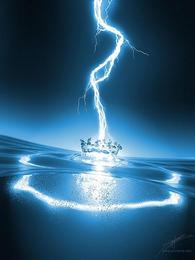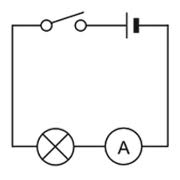Electricity Current

- defined as the rate of flow of electric charge
- There is electric current only when there are moving electric charges
- I = Q / t
- where Q is the amount of charge flows (in C), and t is the time taken (in s)
- SI unit is ampere, A
- The ammeter, milliammeter, and microammeter are current-measuring instruments and must be connected in series in the circuit
Potential difference V and electromotive force, emf
Cells in series
Cells in parallel
Example To transfer 2 C of charge from points X to Y in an electrical circuit 50 J of energy is needed. What is the potential difference between X and Y? Solution Potential difference between X and Y = 50 / 2 = 25 V
|
Ohm's Law and Resistance

- Ohm's Law states that the current I, passing through a conductor is directly proportional to the potential difference, V between its ends provided that the physical conditions and temperature of the conductor remain constant.
- a resistor is a conductor with known value of resistance. It can be used to control (reduce) the size of current flowing in a circuit.
- Resistance, is therefore a measure of how difficult it is for the current to pass through the circuit.
- V / I = constant

- Conductors or resistors which obey Ohm's Law are called ohmic.
- Eg. pure metal, copper sulphate solution with copper electrodes, metal alloy
- Those which do not obey Ohm's Law are called non-ohmic.
- The resistance, R of an electrical component is defined as the ratio of the potential difference, V across the component to the current, I flowing through it.
Rheostat

- a variable resistor used to vary the control of electric current

- The voltmeter is connected in parallel
- Use the rheostat to adjust the size of the current to a convenient value. Hence, record the readings shown on the ammeter and voltmeter
- adjust the rheostat to take 5 sets of readings of I and V
- Calculate the resistance from the equation R = V / I
Factors affecting resistance of a wire
1. Length
- for a wire of uniform cross-sectional area, the resistance is directly proportional to the length of the wire
- hence, the longer the wire, the higher the resistance
- for a wire of fixed length, its resistance is inversely proportional to the cross-sectional area
- so, the thinner the wire, the higher the resistance
- resistance depends on the kind of substance
- copper is a good conductor and is used for connected wires
- nichrome has more resistance and is used in the heating elements of electric heater
- for metallic wires, as temperature increases, the resistance increases
- but for some materials like silicon and germanium as temperature increases, the resistance decreases
Electric Circuits

An electric circuit is a complete or closed path through which electric charges flow from one terminal of an electrical source to the other, passing through one or more circuit components.
Series circuit
Series circuit
- It has only one path for the current to flow.
- the sum of voltages across individual components in the circuit is equal to the voltage across the terminals of the electrical source or the whole circuit.
- Application: voltage divider

Parallel circuit
- It has more than 1 path for the current to flow
- The sum of the currents flowing in the separate branches of a parallel circuit is equal to the current from the source.
- Application: electrical household connections
Short circuit
- A short circuit occurs when a large current flows due to the very little or negligible resistance of the circuit
- A short circuit leads to
- overheating of wires which may cause electric fires
- damage of the electrical source (eg battry) and other circuit components
- To prevent short circuits, use fuse
Diode

- A diode allows the electric current to flow in only ONE direction
- The follow arrow on the diode symbol shows that it is forward biased - the current flows easily
- The reverse arrow shows that the diode is reverse biased - the current is nearly zero
Rectifier

- in a direct current or d.c. circuit, the current only flows in one direction, ie from positive to negative
- in a alternating current or a.c. circuit, the power supply can be controlled in such a way that the current alternates between forward and reverse directions, ie from positive to negative for a short period, then from negative to positive for another short period
- since a diode only lets current flow in the forward direction and stops all the reverse current, an a.c. can be changed into a d.c. by using a diode
- the conversion of an a.c. into a d.c. is called rectification
- the diode used to achieve rectification is called rectifier
- in half-wave rectification, the diode conducts in the forward half cycle of the a.c. (forward biased) and cuts off the reverse half cycle of the a.c. (reverse biased)



